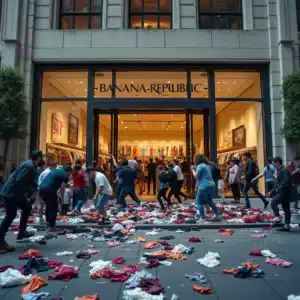Is Commense Fast Fashion? The Best Analysis of Its Impact
Introduction: Is Commense Fast Fashion
When you see the latest trendy pieces from Commense flooding your social media, do you ever pause and think about where they’re coming from? You’ve probably heard the term “fast fashion” thrown around, but what does it actually mean for the clothes you wear and the world you live in? Today, we’re diving into one of the most popular brands in this industry—Commense—and breaking down the real impact it has on your wardrobe, the environment, and global communities. By the end of this article, you’ll have a better understanding of the true cost of fast fashion and how you can make informed, more sustainable choices.
Table of Contents
Understanding Fast Fashion and the Role of Commense
What Is Fast Fashion?
Fast fashion refers to the rapid production of cheap, trendy clothing that mirrors current runway styles. These clothes are designed to be mass-produced and sold at affordable prices, which encourages customers to buy frequently and dispose of garments quickly. Fast fashion companies produce new collections several times a year, giving shoppers the opportunity to constantly update their wardrobe without breaking the bank.
Is Commense Fast Fashion?
Yes, Commense is a brand that operates within the fast fashion model. It is known for its affordable, trendy clothing that hits the shelves quickly to satisfy consumer demand. Just like other fast fashion giants, Commense focuses on bringing runway-inspired designs to the mass market at a fraction of the price of luxury brands. While this approach has made it extremely popular among fashion-forward individuals, it comes with a host of consequences that are often overlooked by consumers.

The Environmental Impact of Commense Fast Fashion
When you purchase that $10 dress from Commense, you may not immediately consider the environmental toll associated with its production. However, fast fashion as a whole—Commense included—has a massive carbon footprint that affects the planet in several ways.
Textile Waste: A Growing Problem
The fast fashion industry produces enormous quantities of clothing each year, much of which ends up in landfills. According to the Ellen MacArthur Foundation, the fashion industry produces 92 million tons of textile waste annually. Fast fashion brands like Commense contribute to this issue by encouraging consumers to frequently buy and discard clothes, creating a cycle of waste that’s hard to break.
- Quick Turnover of Trends: By producing clothing in large quantities and for short periods, Commense adds to the waste when items go unsold and eventually get discarded.
- Disposable Culture: With each passing season, people throw away items to make room for newer trends, leading to a constant accumulation of fashion waste.
The Water Footprint of Fast Fashion
Did you know that it takes about 2,700 liters of water to make a single cotton t-shirt? That’s enough water for one person to drink for 2.5 years. Fast fashion brands like Commense rely heavily on cotton, one of the thirstiest crops in the world. The production of cotton and other materials used in cheap clothing requires vast amounts of water—much of it sourced from areas already facing water scarcity.
- Overuse of Water Resources: The mass production of clothing depletes water supplies in regions that can’t afford to waste this precious resource.
- Chemical Pollution: The textile industry also uses harmful chemicals in dyeing and finishing fabrics, which can end up contaminating rivers and groundwater.
Carbon Emissions and the Fashion Supply Chain
The global supply chain for fast fashion is highly carbon-intensive. From the raw materials used in production to the shipping of clothes worldwide, each step leaves behind a significant carbon footprint. Fast fashion brands like Commense, with their rapid turnover of clothing, significantly contribute to climate change.
- Transportation: Fast fashion often relies on cheap labor in developing countries, which means long shipping routes from factories in Asia to retail stores worldwide, increasing the carbon emissions.
- High Energy Use: The process of manufacturing, dyeing, and finishing fabrics is energy-intensive, often relying on non-renewable energy sources.
The Social and Ethical Concerns of Commense Fast Fashion
While you’re enjoying the affordability and trendiness of Commense’s clothing, it’s crucial to consider the social and ethical implications behind these products. Fast fashion brands, including Commense, often source their garments from developing countries where labor laws are less strict and wages are low.
Exploitative Labor Practices
The cheap prices of fast fashion come at a high cost to workers in garment factories. Many of these workers are paid pennies per hour, and their working conditions can be unsafe and exploitative. In many cases, these workers are subjected to long hours and poor conditions in exchange for minimal pay.
- Child Labor: Although many fast fashion brands claim to monitor their supply chains, there are still instances of child labor in the industry, where children are forced to work in factories under dangerous conditions.
- Low Wages: The low wages paid to garment workers often fail to meet the cost of living in many of the countries where these workers are based, trapping them in poverty.

Factory Safety Concerns
There have been numerous reports of unsafe working conditions in garment factories, some of which have resulted in tragic accidents. The 2013 Rana Plaza collapse in Bangladesh, which killed over 1,100 workers, is one of the most notorious examples of the dangers faced by garment workers in the fast fashion industry.
- Lack of Proper Safety Measures: Many factories lack proper safety equipment and regulations, leading to preventable accidents.
- Exploitation of Vulnerable Populations: Workers, often women and children, are taken advantage of in countries with weak labor laws, as they are forced to accept low-paying, dangerous jobs out of desperation.
The Economic Impact of Fast Fashion on Consumers
While Commense offers trendy clothing at rock-bottom prices, it’s important to understand the broader economic implications of the fast fashion industry on consumers and local economies.
Encouraging Overconsumption
Fast fashion creates a cycle of overconsumption by offering constant new products at low prices. This encourages shoppers to buy more than they need, which eventually leads to a disposable mentality. As consumers, we’re encouraged to “buy now, wear once, discard later.”
- Perceived Value: Because the clothes are so affordable, consumers often view them as disposable items, which drives up the demand for cheap, trendy items that don’t last.
- Decline in Quality: The focus on quantity over quality means that many fast fashion items break down after just a few wears, further encouraging a “buy, wear, throw away” culture.
Impact on Local Businesses
As fast fashion giants like Commense grow, local fashion businesses often struggle to compete with the low prices offered by mass-produced clothing. This leads to a decline in the local fashion industry and a shift toward unsustainable production methods.
- Job Losses in Local Fashion Markets: Smaller, local businesses that focus on higher-quality, sustainable clothing are often outcompeted by the affordability of fast fashion, leading to closures and job losses.
- Economic Dependence on Cheap Imports: Economies that rely heavily on fast fashion imports may suffer in the long run, as the cycle of cheap goods undermines more sustainable, locally driven industries.
How You Can Make a Difference: Your Role in Sustainable Fashion
Now that you’re aware of the real impact of Commense and similar fast fashion brands, you may be wondering how you can make more sustainable choices moving forward. The good news is that even small changes can have a big impact. Here’s how you can contribute to reducing the negative effects of fast fashion.

Choose Sustainable Brands
One of the most effective ways to combat the impact of fast fashion is to support brands that prioritize sustainability and ethical practices. Look for companies that offer transparency about their supply chains and use eco-friendly materials.
- Eco-friendly Materials: Brands that use organic cotton, recycled fabrics, and other sustainable materials help reduce the environmental impact of clothing production.
- Fair Trade Practices: Look for brands that pay fair wages and provide safe working conditions for their employees.
Buy Less, But Better
Instead of falling into the trap of constant consumption, focus on buying fewer, higher-quality pieces that will last longer. Opt for timeless pieces that never go out of style, rather than chasing fleeting trends.
- Quality Over Quantity: Invest in durable clothing that you can wear for years, rather than disposable fashion that falls apart after a few washes.
- Secondhand Shopping: Consider buying secondhand or vintage clothing, which reduces the demand for new production and helps keep garments in circulation longer.
Conclusion: The True Cost of Fast Fashion
Is Commense fast fashion? The answer is yes, but the real question is—what’s the true cost of the trendy, affordable clothes we buy from brands like Commense? From environmental degradation to exploitative labor practices and unsustainable consumer behavior, the impact of fast fashion is significant and far-reaching.
Now that you’re armed with the knowledge of how fast fashion affects the world, it’s up to you to make more conscious decisions in your own wardrobe. By choosing sustainable alternatives, reducing consumption, and supporting ethical practices, you can help create a more sustainable and fair fashion industry.
Call to Action:
Ready to make a change? Start by exploring sustainable fashion brands today, and take the first step towards a more ethical, eco-friendly wardrobe. Your choices matter more than you think.













Add comment